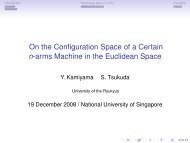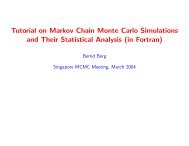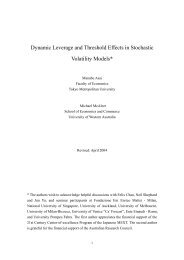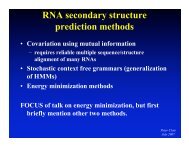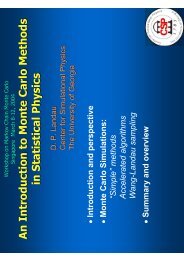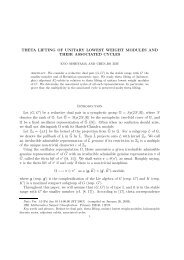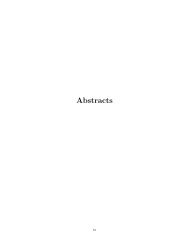Stein's method, Malliavin calculus and infinite-dimensional Gaussian
Stein's method, Malliavin calculus and infinite-dimensional Gaussian
Stein's method, Malliavin calculus and infinite-dimensional Gaussian
Create successful ePaper yourself
Turn your PDF publications into a flip-book with our unique Google optimized e-Paper software.
Proof of Lemma 10.1 (see also [66, Lemma 2]). Without loss of generality, we can<br />
assume that H = L 2 (Z; Z; ), where (A; Z) is a Polish space, <strong>and</strong> is a -…nite <strong>and</strong> non-atomic<br />
measure. Thus, we can write<br />
Z<br />
hDF; DGi H = p q hI p 1 (f); I q 1 (g)i H<br />
= p q I p 1 f(; z) I q 1 g(; z) (dz)<br />
It follows that<br />
=<br />
E<br />
" <br />
a<br />
8<br />
><<br />
>:<br />
If r < p q then<br />
Z p^q<br />
X1<br />
p 1<br />
= p q r!<br />
A<br />
r<br />
r=0<br />
p^q<br />
X1<br />
p 1<br />
= p q r!<br />
r<br />
r=0<br />
Xp^q<br />
p 1<br />
= p q (r 1)!<br />
r 1<br />
r=1<br />
#<br />
1<br />
2<br />
q hDF; DGi H<br />
a 2 + p 2 P p<br />
p 1<br />
r=1 (r 1)!2<br />
r 1<br />
q 1<br />
r<br />
Z<br />
q 1<br />
r<br />
q 1<br />
r 1<br />
2 q 1<br />
<br />
I p+q 2 2r f(; z)e r g(; z) (dz)<br />
<br />
I p+q 2 2r (f e r+1 g)<br />
I p+q<br />
2r (f e r g):<br />
r 1 2(p + q 2r)!kf e r gk 2 H (p+q 2r) if p < q;<br />
(10.13)<br />
(a p!hf; gi H p) 2 + p 2 P p 1<br />
p 1 4(2p<br />
r=1 (r 1)!2<br />
r 1<br />
2r)!kf e r gk 2 if p = q:<br />
H (2p 2r)<br />
kf e r gk 2 H (p+q 2r) kf r gk 2 H (p+q 2r) = hf p r f; g q r gi H 2r<br />
If r = p < q, then<br />
kf p r fk H 2rkg q r gk H 2r<br />
1 2 kf p r fk 2 H 2r + kg q r gk 2 H 2r <br />
:<br />
kf e p gk 2 H (q p) kf p gk 2 H (q p) kfk 2 H p kg q p gk H 2p:<br />
If r = p = q, then f e p g = hf; gi H p: By plugging these last expressions into (10.13), we deduce<br />
immediately the desired conclusion.<br />
The combination of the results presented in this section with Theorem 10.1 lead to the<br />
following statement, which is a collection of the main …ndings contained in the papers by Peccati<br />
<strong>and</strong> Tudor [73] <strong>and</strong> Nualart <strong>and</strong> Ortiz-Latorre [66].<br />
Theorem 10.2 (See [66, 73]) Fix d 2 <strong>and</strong> let C = fC(i; j) : i; j = 1; :::; dg be a d d<br />
positive de…nite matrix. Fix integers 1 q 1 : : : q d . For any n 1 <strong>and</strong> i = 1; : : : ; d, let f (n)<br />
i<br />
belong to H q i<br />
. Assume that<br />
F (n) = (F (n)<br />
1 ; : : : ; F (n)<br />
d<br />
) = (I q1 (f (n)<br />
1 ); : : : ; I qd (f (n)<br />
d<br />
)) n 1;<br />
is such that<br />
lim<br />
n!1<br />
(n)<br />
E[F<br />
i<br />
F (n)<br />
j<br />
] = C(i; j); 1 i; j d: (10.14)<br />
Then, as n ! 1, the following four assertions are equivalent:<br />
52



